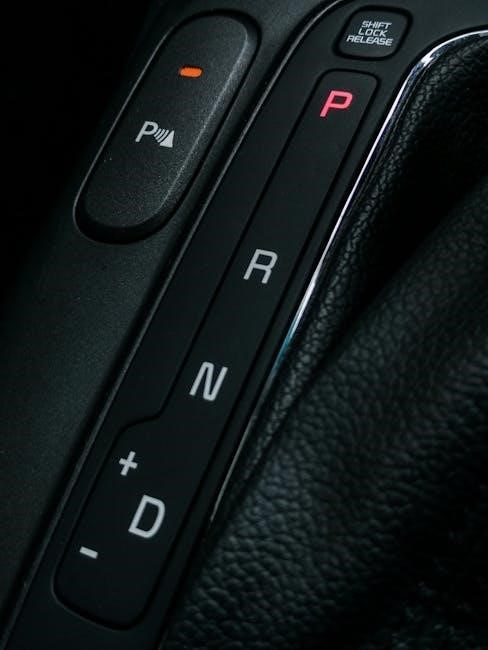
manual shifter for automatic transmission
A manual shifter for an automatic transmission offers drivers enhanced control, allowing gear changes without a clutch, blending convenience with driving engagement for enthusiasts seeking precision.
What is a Manual Shifter for Automatic Transmissions?
A manual shifter for automatic transmissions is a component that enables drivers to manually control gear shifts in vehicles equipped with automatic transmissions. Unlike traditional manual transmissions, it eliminates the need for a clutch pedal, allowing drivers to switch gears electronically or mechanically through paddle shifters or a gear selector. This system provides a hybrid driving experience, combining the convenience of an automatic transmission with the driver engagement of manual control. It is often integrated into modern vehicles to enhance performance and driver involvement without sacrificing the ease of automatic operation.
History and Evolution of Manual Shifters in Automatic Cars
The concept of manual shifters in automatic cars emerged in the late 20th century, blending the convenience of automatic transmissions with the driver engagement of manual shifting. Early systems were mechanical but evolved into electronic controls by the 2000s. Paddle shifters became popular, offering precise gear changes without a clutch. Modern systems integrate advanced computer controls, enabling seamless shifting while maintaining automatic functionality. This innovation catered to enthusiasts seeking enhanced driving experiences, marking a significant evolution in automotive technology.
Features of Manual Shifters in Automatic Transmissions
Manual shifters in automatic transmissions offer precision control, paddle shifters, and sport modes, combining driver engagement with automatic ease for a dynamic driving experience.
Paddle Shifters: Design and Functionality
Paddle shifters are mounted on the steering wheel, offering quick gear changes without removing hands from the wheel. They typically consist of two levers, one for upshifting and one for downshifting. This design enhances driver control, especially during spirited driving. When activated, the car’s computer adjusts the transmission to the selected gear, providing a more engaging experience. Paddle shifters are often paired with sport modes, optimizing performance by holding lower gears for better acceleration and responsiveness. They balance convenience with driver involvement, making them a popular feature in modern vehicles.
Manual Shifter Modes: Sport, Manual, and Semi-Automatic
Modern automatic transmissions with manual shifters often feature multiple modes to suit driving conditions. Sport mode sharpens throttle response and holds lower gears for better acceleration. Manual mode allows full driver control, preventing automatic shifting. Semi-automatic mode blends convenience, enabling manual shifts without fully disengaging the car’s automatic functionality. These modes cater to diverse driving styles, offering flexibility for both performance and everyday driving scenarios, while maintaining the ease of use associated with automatic transmissions. Each mode is designed to enhance the driving experience by providing the right balance of control and comfort.
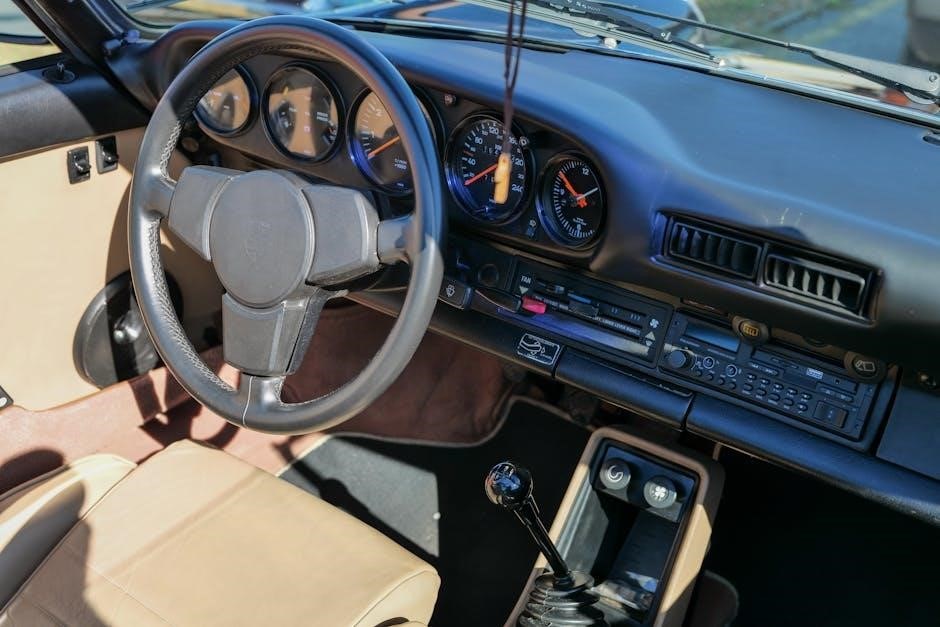
Functionality and Operation of Manual Shifters
Manual shifters in automatic transmissions enable drivers to control gear shifts via paddles or a gear lever, enhancing control during driving without requiring a clutch pedal.
How Manual Shifters Work in Automatic Transmissions
Manual shifters in automatic transmissions function by allowing drivers to control gear shifts electronically. Paddles or a shifter engage the system, sending signals to the transmission control module (TCM). The TCM processes these inputs, determining if a manual shift is appropriate based on speed and engine RPM. If conditions are suitable, the transmission adjusts gears accordingly. This system provides a balance of driver control and automatic efficiency, with the engine computer ensuring smooth transitions and preventing unsafe shifts. The driver receives feedback through gear indicators, enhancing the driving experience while maintaining reliability and performance.
Limitations of Manual Shifters in Automatic Cars
Manual shifters in automatic cars have limitations, including reduced fuel efficiency if misused. Over-shifting can strain the transmission, potentially causing wear. Additionally, improper downshifting may lead to engine RPM surges, risking damage. The system’s reliance on electronic controls means malfunctions can disable manual mode. Furthermore, manual shifting may not always override automatic decisions, limiting driver input in certain conditions. These constraints highlight the need for careful use to avoid compromising transmission health and performance. Proper techniques are essential to maximize benefits and minimize risks associated with manual shifting in automatic transmissions.
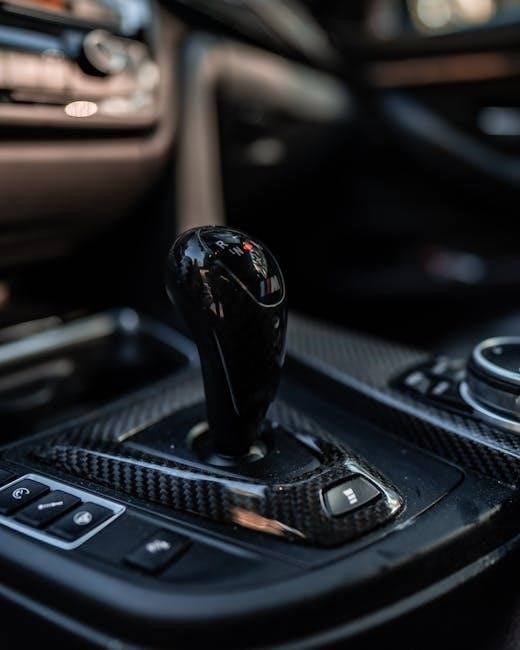
Benefits of Using a Manual Shifter with an Automatic Transmission
Manual shifters enhance driving control, enabling precise gear changes for better performance and fuel efficiency, especially in hilly or dynamic driving conditions, improving overall driving satisfaction and engagement.
Enhanced Driver Control and Performance
Manual shifters provide drivers with greater control over gear transitions, allowing for precise adjustments that optimize performance in various driving scenarios. By enabling manual gear changes, drivers can tailor their driving experience to specific conditions, such as steep hills or dynamic roadways, ensuring better responsiveness and stability. This feature enhances the connection between the driver and the vehicle, fostering a more engaging and personalized driving experience.
Additionally, manual shifters can improve fuel efficiency by allowing drivers to select the most appropriate gear for the situation, reducing unnecessary shifts and maintaining optimal engine performance. This blend of control and efficiency makes manual shifters a popular choice for drivers seeking a balance between convenience and driving dynamics.
Fuel Efficiency and Improved Driving Experience
Manual shifters in automatic transmissions can enhance fuel efficiency by allowing drivers to select the optimal gear for specific driving conditions, reducing unnecessary shifts and engine strain. This control often leads to better mileage, especially in hilly or varying terrains where automatic systems might struggle to adapt. Additionally, the ability to manually shift gears provides a more engaging and responsive driving experience, making journeys more enjoyable and immersive for enthusiasts who value precision and connectivity with their vehicle.
Driving Techniques with a Manual Shifter in an Automatic Car
Mastering manual shifting enhances control, especially on hills and highways, by allowing drivers to downshift for descents or upshift for steady speeds, optimizing performance and fuel use.
When to Use Manual Mode: Hills, Highways, and Cities
Manual mode excels in varied terrains: hills benefit from lower gears to maintain speed and control, highways allow for optimal cruising, and cities require frequent shifts to navigate traffic efficiently.
Mastering Downshifting and Upshifting Techniques
Mastering downshifting and upshifting techniques enhances control and efficiency. Downshifting before hills or when decelerating helps maintain speed and avoid brake wear, while upshifting smoothly on climbs prevents over-revving. Listen to engine RPMs to guide shifts, ensuring seamless transitions. Proper timing prevents transmission strain and optimizes fuel use. Practice in various terrains to refine your skill, adapting to road conditions for a smoother, more responsive drive.
Maintenance and Care for Manual Shifters in Automatic Cars
Regularly inspect shifter components, ensure proper lubrication, and avoid aggressive shifting to prevent wear. Schedule professional checks to maintain optimal performance and longevity of the system.
Common Issues with Manual Shifters and Solutions
Common issues include delayed shifting, erratic gear changes, or failure to engage gears. These often stem from worn sensors, faulty solenoids, or software glitches. Solutions involve recalibrating the system, replacing damaged components, or updating transmission software. Regular maintenance, such as checking transmission fluid levels and ensuring clean connections, can prevent these problems. Addressing issues promptly helps maintain smooth operation and prevents further damage to the transmission system.
Best Practices for Longevity of Manual Shifter Components
To ensure longevity, avoid aggressive or frequent manual shifting, especially in extreme temperatures. Regularly check and maintain transmission fluid levels, as low or degraded fluid can strain components. Avoid riding the brakes while in manual mode, as this can cause unnecessary wear. Additionally, staying updated with software enhancements and adhering to manufacturer guidelines for maintenance can significantly extend the life of manual shifter components and overall transmission health.

The Future of Manual Shifters in Automatic Transmissions
Advancements in shifter technology, such as AI integration and adaptive systems, are expected to enhance driver experience, while market demand for hybrid and electric vehicles influences design evolution.
Advancements in Shifter Technology and Design
Modern manual shifters for automatic transmissions feature paddle shifters, AI-driven adaptive systems, and ergonomic designs. These advancements enhance driver control and comfort, offering precise gear changes. Integration with hybrid and electric powertrains is on the rise, optimizing performance and efficiency. Haptic feedback and customizable shift modes further elevate the driving experience, catering to both enthusiasts and everyday drivers. Such innovations ensure manual shifters remain relevant in evolving automotive landscapes.
Market Trends and Consumer Demand for Manual Shifters
Consumer demand for manual shifters in automatic transmissions is driven by driving enthusiasts seeking enhanced control and sporty experiences. Premium brands like BMW and Audi lead in integrating advanced shifter technologies, while mass-market brands are adapting to meet growing interest in performance driving. The rise of hybrid and electric vehicles has also sparked innovation, blending efficiency with manual shifting capabilities. As automotive technology evolves, manual shifters continue to attract a niche yet dedicated consumer base, ensuring their relevance in modern vehicles.
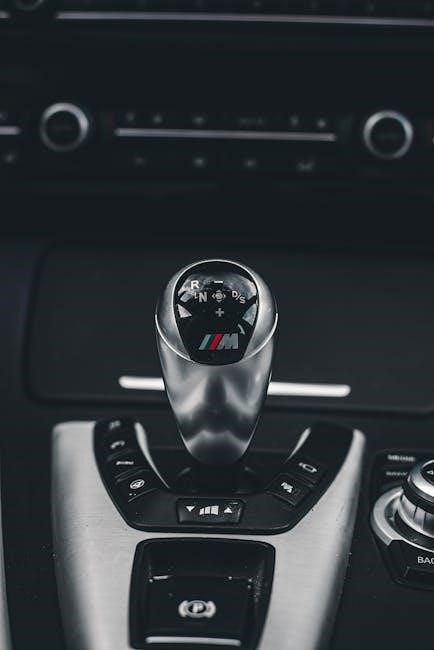
Common Mistakes to Avoid When Using a Manual Shifter
Avoid over-shifting, which strains the transmission, and ignoring gear shift indicators, as these practices can harm the transmission and reduce its longevity and performance.
Over-Shifting and Its Impact on Transmission Health
Over-shifting, or frequent unnecessary gear changes, can strain the automatic transmission’s components, leading to premature wear. This habit can cause overheating, reduce fluid efficiency, and potentially result in costly repairs. Drivers should avoid excessive shifting, especially in city driving or light traffic, as it offers no performance benefits and only stresses the system. Proper shifting techniques and awareness of driving conditions can help preserve transmission health and longevity, ensuring smoother and more efficient vehicle operation over time.
Ignoring Gear Shift Indicators and Warning Signs
Neglecting gear shift indicators and warning signs can lead to transmission damage and suboptimal performance. Modern vehicles provide alerts for optimal shifting, ensuring efficiency and longevity. Ignoring these signals may result in overheating, reduced fuel efficiency, and potential mechanical failure. Regular monitoring of dashboard indicators and heeding system warnings are crucial for maintaining transmission health and preventing costly repairs. Consistent disregard can accelerate wear on internal components, emphasizing the importance of attentive driving habits to preserve vehicle functionality and reliability over time.
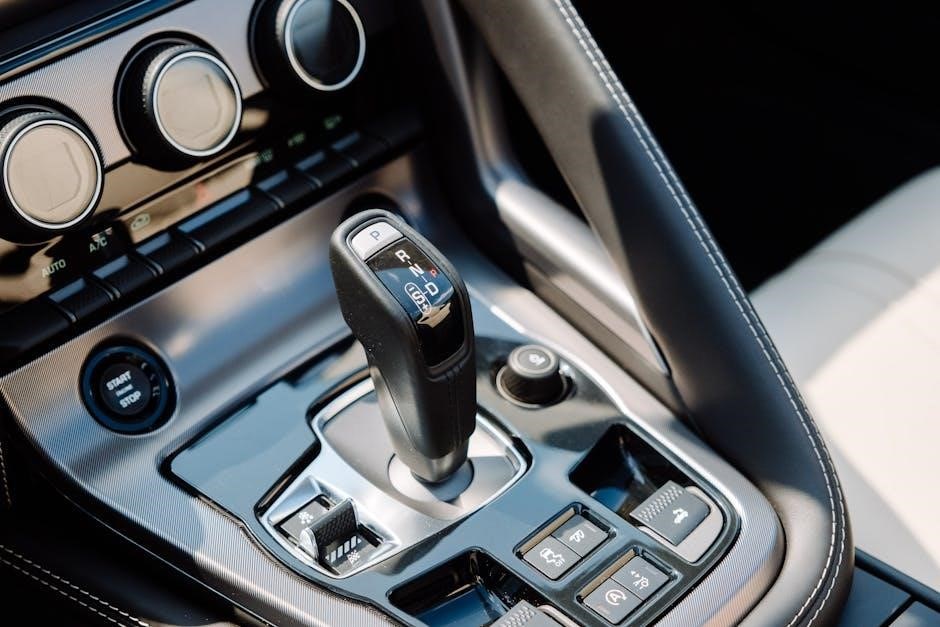
Impact of Manual Shifters on Driving Skills
Manual shifters refine situational awareness and reaction time, enhancing mechanical sympathy and car control, transforming drivers into more engaged and skilled operators behind the wheel.
Improving Situational Awareness and Reaction Time
Using a manual shifter in an automatic transmission heightens situational awareness by requiring active engagement with the car’s behavior. This engagement fosters quicker reaction times as drivers anticipate and respond to road conditions, such as hills or sudden stops, more effectively. The need to manually shift gears encourages a deeper connection with the vehicle, enhancing the ability to predict and adapt to driving scenarios, thereby improving overall safety and control.
Enhancing Mechanical Sympathy and Car Control
Manual shifters foster mechanical sympathy by encouraging drivers to anticipate and respond to the car’s needs, such as engine speed and torque demand. This connection enhances car control, allowing for smoother acceleration and deceleration. By actively managing gear shifts, drivers develop a deeper understanding of their vehicle’s behavior, leading to more precise and intentional driving. This synergy between driver and machine improves overall performance and reduces strain on the transmission, creating a more efficient and enjoyable driving experience.
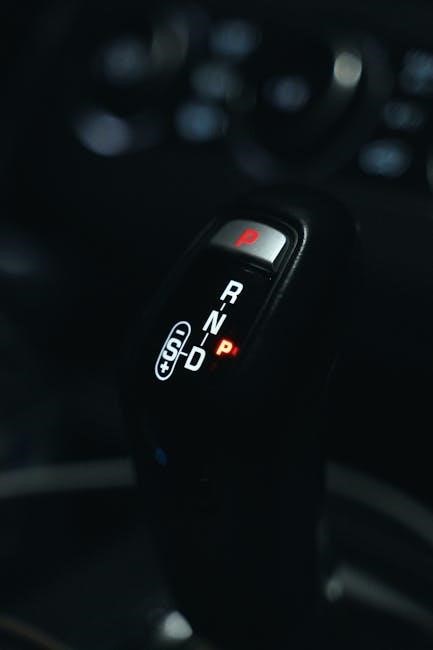
Comparison of Manual Shifters Across Different Car Brands
Premium brands like BMW and Audi offer precise, performance-oriented shifters, while mass-market brands like Toyota focus on practicality. Each brand tailors shifter design to its target audience.
Premium Brands: BMW, Mercedes, and Audi
Premium brands like BMW, Mercedes, and Audi excel in blending luxury with performance. Their manual shifters, often paddle-actuated, provide precise control and seamless integration with automatic transmissions, enhancing driver engagement. These systems typically feature adaptive algorithms that learn driver behavior, optimizing gear shifts for dynamic driving scenarios. Ergonomic designs and high-quality materials further elevate the driving experience, making these shifters a hallmark of premium vehicles. They cater to enthusiasts seeking both comfort and sporty handling, ensuring a refined yet responsive ride across various road conditions and driving styles.
Mass-Market Brands: Toyota, Honda, and Ford
Mass-market brands like Toyota, Honda, and Ford offer practical and user-friendly manual shifters for automatic transmissions. These systems emphasize ease of use and reliability, catering to everyday drivers. Toyota’s systems often feature intuitive paddle shifters, while Honda focuses on seamless integration with their automatic transmissions. Ford’s approach includes sport-tuned modes for enhanced responsiveness. These brands prioritize accessibility, ensuring their manual shifters are both functional and affordable. Their designs aim to deliver a balance of comfort and driver engagement, making them appealing to a wide range of consumers seeking control without sacrificing convenience.
Manual shifters for automatic transmissions bridge convenience and control, offering drivers enhanced engagement without sacrificing ease, making them a versatile choice for modern driving experiences and preferences.
Final Thoughts on Manual Shifters for Automatic Transmissions
Manual shifters for automatic transmissions strike a balance between convenience and driver engagement, offering precise control without the need for a clutch. They cater to enthusiasts who crave a more connected driving experience while maintaining the ease of automatic gear selection. These systems shine in specific scenarios, such as downhill driving or sporty maneuvers, where manual intervention enhances performance. However, they may not suit all drivers, as frequent shifting can be less efficient in heavy traffic. Ultimately, manual shifters provide a unique compromise for those seeking a blend of traditional driving feel and modern convenience.
Recommendations for Drivers Considering a Manual Shifter
Drivers contemplating a manual shifter for their automatic transmission should first assess their driving habits and needs. For those who frequent hilly terrains or enjoy sporty driving, manual shifters can enhance control and performance. Practice mastering downshifting and upshifting techniques to avoid unnecessary wear on the transmission. Regular maintenance, such as checking transmission fluid levels, is crucial for longevity. Additionally, avoid over-reliance on manual mode in heavy traffic, as this can reduce fuel efficiency. Finally, familiarize yourself with the vehicle’s specific shifter mechanics to optimize your driving experience and ensure smooth operation.
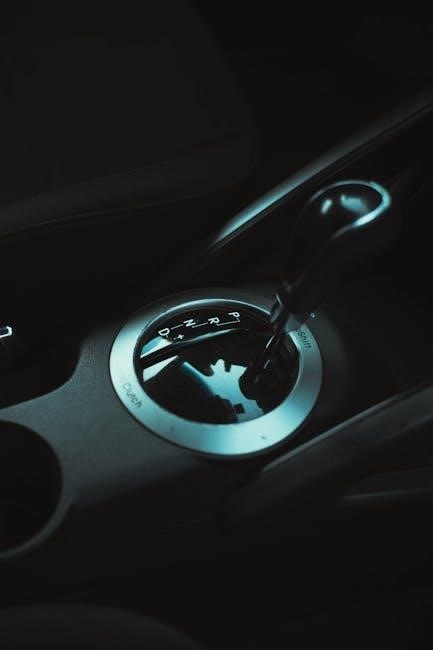
Additional Resources
Explore online tutorials, forums, and manufacturer guides for detailed insights and troubleshooting tips on manual shifters, ensuring a comprehensive understanding of their operation and benefits.
Recommended Reading and Tutorials for Manual Shifter Users
For mastering manual shifters, explore tutorials on paddle shifter techniques, sport mode usage, and downshifting strategies. Manufacturer guides and online forums offer practical insights. Start with basic tutorials to understand gear control, then progress to advanced guides for optimizing performance. Websites like Wyzant and automotive blogs provide step-by-step instructions. Engage with communities like Reddit’s r/cars for real-world tips. These resources help drivers enhance their skills and troubleshoot common issues, ensuring a smooth and efficient driving experience with manual shifters in automatic transmissions.
Online Communities and Forums for Enthusiasts
Join forums like Reddit’s r/cars and specialized automotive communities to connect with enthusiasts. These platforms offer discussions on manual shifter techniques, troubleshooting, and performance optimization. Share experiences, gain insights, and learn from experts. Engage with threads on transmission modifications and driver tips. Participate in polls and Q&A sessions to refine your skills. Online communities foster collaboration and knowledge-sharing, helping you maximize the potential of your manual shifter in an automatic transmission setup for a more engaging drive.